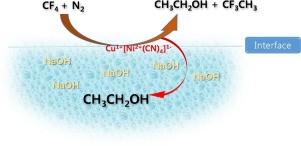当前位置:
X-MOL 学术
›
J. Ind. Eng. Chem.
›
论文详情
Our official English website, www.x-mol.net, welcomes your feedback! (Note: you will need to create a separate account there.)
Sustainable degradation of carbon tetrafluoride to non-corrosive useful products by incorporating reduced electron mediator within electro-scrubbing
Journal of Industrial and Engineering Chemistry ( IF 6.1 ) Pub Date : 2018-07-01 , DOI: 10.1016/j.jiec.2018.02.025 G. Muthuraman , A.G. Ramu , Y.H. Cho , E.J. McAdam , I.S. Moon
Journal of Industrial and Engineering Chemistry ( IF 6.1 ) Pub Date : 2018-07-01 , DOI: 10.1016/j.jiec.2018.02.025 G. Muthuraman , A.G. Ramu , Y.H. Cho , E.J. McAdam , I.S. Moon

|
Abstract The degradation of CF4 gas using existing technologies produces other types of greenhouse gas (CO2) and corrosive side products. The main aim of this study is to degrade CF4 gas at room temperature into useful products without producing corrosive side products by mediated electrochemical reduction (MER) process using an electrogenerated Cu1+[Ni2+(CN)4]1− mediator. Initial studies on the electrolytic reduction of the hetero-bimetallic complex in catholyte solution at anodized Ti cathode was monitored by oxidation/reduction potential (ORP) variation whether the Cu2+ or Ni2+ was reduced in the Cu2+[Ni2+(CN)4] and confirmed by electron spin resonance (ESR) spectroscopy the Cu1+[Ni2+(CN)4]1− formation. The concentration variation of Cu1+[Ni2+(CN)4]1− during CF4 injection demonstrated the degradation of CF4 followed the MER by electrogenerated Cu1+[Ni2+(CN)4]1−. Maximum removal efficiency of CF4 using electroscrubbing process was 96% at room temperature. Through the variation in gas phase parameters, the gas phase mass transfer coefficient was calculated that can facilitate scale up the developed process. Fourier transform infrared spectroscopy analysis in both the gas and solution phases showed that CH3CH2OH was the main product that formed during the removal of CF4 by electrogenerated Cu1+[Ni2+(CN)4]1− at electroscrubber along with a small amount of CF3CH3 intermediate. Importantly, this mechanism also avoided formation of the corrosive product HF.
中文翻译:

通过在电洗涤中加入还原电子介体,将四氟化碳可持续降解为无腐蚀性的有用产品
摘要 使用现有技术降解 CF4 气体会产生其他类型的温室气体 (CO2) 和腐蚀性副产品。本研究的主要目的是通过介导电化学还原 (MER) 过程使用电生成的 Cu1+[Ni2+(CN)4]1- 介质在室温下将 CF4 气体降解为有用的产品,而不会产生腐蚀性副产品。通过氧化/还原电位 (ORP) 的变化监测阳极氧化钛阴极阴极电解液中异质双金属配合物的电解还原的初步研究,无论是 Cu2+ 还是 Ni2+ 在 Cu2+[Ni2+(CN)4] 中被还原,并通过以下方式证实电子自旋共振 (ESR) 光谱分析 Cu1+[Ni2+(CN)4]1- 形成。CF4注入过程中Cu1+[Ni2+(CN)4]1-的浓度变化证明了CF4的降解跟随MER通过电产生的Cu1+[Ni2+(CN)4]1-。在室温下,使用电洗涤工艺对 CF4 的最大去除效率为 96%。通过气相参数的变化,计算出气相传质系数,这有助于扩大所开发的工艺。气相和溶液相的傅里叶变换红外光谱分析表明,CH3CH2OH 是在电洗涤器中通过电产生的 Cu1+[Ni2+(CN)4]1- 去除 CF4 过程中形成的主要产物,以及少量的 CF3CH3 中间体。重要的是,这种机制还避免了腐蚀性产物 HF 的形成。在室温下,使用电洗涤工艺对 CF4 的最大去除效率为 96%。通过气相参数的变化,计算出气相传质系数,这有助于扩大所开发的工艺。气相和溶液相的傅立叶变换红外光谱分析表明,CH3CH2OH 是在电洗涤器中通过电产生的 Cu1+[Ni2+(CN)4]1- 去除 CF4 过程中形成的主要产物,以及少量的 CF3CH3 中间体。重要的是,这种机制还避免了腐蚀性产物 HF 的形成。在室温下,使用电洗涤工艺对 CF4 的最大去除效率为 96%。通过气相参数的变化,计算出气相传质系数,这有助于扩大所开发的工艺。气相和溶液相的傅立叶变换红外光谱分析表明,CH3CH2OH 是在电洗涤器中通过电产生的 Cu1+[Ni2+(CN)4]1- 去除 CF4 过程中形成的主要产物,以及少量的 CF3CH3 中间体。重要的是,这种机制还避免了腐蚀性产物 HF 的形成。气相和溶液相的傅立叶变换红外光谱分析表明,CH3CH2OH 是在电洗涤器中通过电产生的 Cu1+[Ni2+(CN)4]1- 去除 CF4 过程中形成的主要产物,以及少量的 CF3CH3 中间体。重要的是,这种机制还避免了腐蚀性产物 HF 的形成。气相和溶液相的傅立叶变换红外光谱分析表明,CH3CH2OH 是在电洗涤器中通过电产生的 Cu1+[Ni2+(CN)4]1- 去除 CF4 过程中形成的主要产物,以及少量的 CF3CH3 中间体。重要的是,这种机制还避免了腐蚀性产物 HF 的形成。
更新日期:2018-07-01
中文翻译:

通过在电洗涤中加入还原电子介体,将四氟化碳可持续降解为无腐蚀性的有用产品
摘要 使用现有技术降解 CF4 气体会产生其他类型的温室气体 (CO2) 和腐蚀性副产品。本研究的主要目的是通过介导电化学还原 (MER) 过程使用电生成的 Cu1+[Ni2+(CN)4]1- 介质在室温下将 CF4 气体降解为有用的产品,而不会产生腐蚀性副产品。通过氧化/还原电位 (ORP) 的变化监测阳极氧化钛阴极阴极电解液中异质双金属配合物的电解还原的初步研究,无论是 Cu2+ 还是 Ni2+ 在 Cu2+[Ni2+(CN)4] 中被还原,并通过以下方式证实电子自旋共振 (ESR) 光谱分析 Cu1+[Ni2+(CN)4]1- 形成。CF4注入过程中Cu1+[Ni2+(CN)4]1-的浓度变化证明了CF4的降解跟随MER通过电产生的Cu1+[Ni2+(CN)4]1-。在室温下,使用电洗涤工艺对 CF4 的最大去除效率为 96%。通过气相参数的变化,计算出气相传质系数,这有助于扩大所开发的工艺。气相和溶液相的傅里叶变换红外光谱分析表明,CH3CH2OH 是在电洗涤器中通过电产生的 Cu1+[Ni2+(CN)4]1- 去除 CF4 过程中形成的主要产物,以及少量的 CF3CH3 中间体。重要的是,这种机制还避免了腐蚀性产物 HF 的形成。在室温下,使用电洗涤工艺对 CF4 的最大去除效率为 96%。通过气相参数的变化,计算出气相传质系数,这有助于扩大所开发的工艺。气相和溶液相的傅立叶变换红外光谱分析表明,CH3CH2OH 是在电洗涤器中通过电产生的 Cu1+[Ni2+(CN)4]1- 去除 CF4 过程中形成的主要产物,以及少量的 CF3CH3 中间体。重要的是,这种机制还避免了腐蚀性产物 HF 的形成。在室温下,使用电洗涤工艺对 CF4 的最大去除效率为 96%。通过气相参数的变化,计算出气相传质系数,这有助于扩大所开发的工艺。气相和溶液相的傅立叶变换红外光谱分析表明,CH3CH2OH 是在电洗涤器中通过电产生的 Cu1+[Ni2+(CN)4]1- 去除 CF4 过程中形成的主要产物,以及少量的 CF3CH3 中间体。重要的是,这种机制还避免了腐蚀性产物 HF 的形成。气相和溶液相的傅立叶变换红外光谱分析表明,CH3CH2OH 是在电洗涤器中通过电产生的 Cu1+[Ni2+(CN)4]1- 去除 CF4 过程中形成的主要产物,以及少量的 CF3CH3 中间体。重要的是,这种机制还避免了腐蚀性产物 HF 的形成。气相和溶液相的傅立叶变换红外光谱分析表明,CH3CH2OH 是在电洗涤器中通过电产生的 Cu1+[Ni2+(CN)4]1- 去除 CF4 过程中形成的主要产物,以及少量的 CF3CH3 中间体。重要的是,这种机制还避免了腐蚀性产物 HF 的形成。



























 京公网安备 11010802027423号
京公网安备 11010802027423号